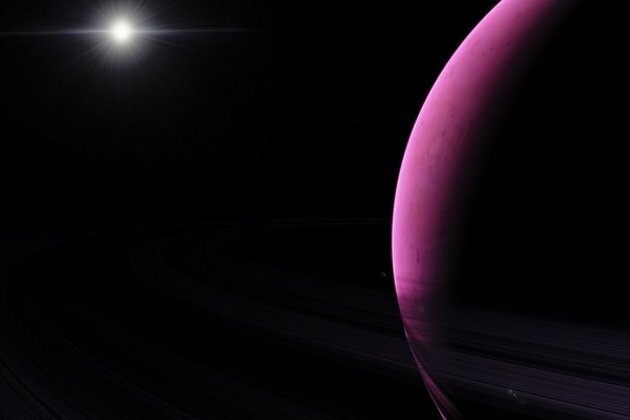Webb telescope reveals exoplanet atmosphere as never seen before
ANI
23 Nov 2022, 12:07 GMT+10

Washington [US], November 23 (ANI): New observations of WASP-39 b reveal a never-before-seen molecule in the atmosphere of a planet sulfur dioxide among other details.
The telescope's array of highly sensitive instruments was trained on the atmosphere of a "hot Saturn" -- a planet about as massive as Saturn orbiting a star some 700 light-years away -- known as WASP-39 b. While JWST and other space telescopes, including Hubble and Spitzer, previously have revealed isolated ingredients of this broiling planet's atmosphere, the new readings provide a full menu of atoms, molecules, and even signs of active chemistry and clouds.
"The clarity of the signals from a number of different molecules in the data is remarkable," says Mercedes Lopez-Morales, an astronomer at the Center for Astrophysics | HarvardSmithsonian and one of the scientists who contributed to the new results.
"We had predicted that we were going to see many of those signals, but still, when I first saw the data, I was in awe," Lopez-Morales adds.
The latest data also give a hint of how these clouds in exoplanets might look up close: broken up rather than a single, uniform blanket over the planet.
The findings bode well for the capability of JWST to conduct the broad range of investigations on exoplanets -- planets around other stars -- scientists hoped for. That includes probing the atmospheres of smaller, rocky planets like those in the TRAPPIST-1 system.
"We observed the exoplanet with multiple instruments that, together, provide a broad swath of the infrared spectrum and a panoply of chemical fingerprints inaccessible until JWST," said Natalie Batalha, an astronomer at the University of California, Santa Cruz, who contributed to and helped coordinate the new research. "Data like these are a game changer."The suite of discoveries is detailed in a set of five newly submitted scientific papers, available on the preprint website arXiv. Among the unprecedented revelations is the first detection in an exoplanet atmosphere of sulfur dioxide, a molecule produced from chemical reactions triggered by high-energy light from the planet's parent star. On Earth, the protective ozone layer in the upper atmosphere is created in a similar way.
"The surprising detection of sulfur dioxide finally confirms that photochemistry shapes the climate of 'hot Saturns,'" says Diana Powell, a NASA Hubble fellow, astronomer at the Center for Astrophysics and core member of the team that made the sulfur dioxide discovery. "Earth's climate is also shaped by photochemistry, so our planet has more in common with 'hot Saturns' than we previously knew!"Jea Adams a graduate student at Harvard and researcher at the Center for Astrophysics analyzed the data that confirmed the sulfur dioxide signal.
"As an early career researcher in the field of exoplanet atmospheres, it's so exciting to be a part of a detection like this," Adams says. "The process of analyzing this data felt magical. We saw hints of this feature in early data, but this higher precision instrument revealed the signature of SO2 clearly and helped us solve the puzzle."At an estimated temperature of 1,600 degrees Fahrenheit and an atmosphere made mostly of hydrogen, WASP-39 b is not believed to be habitable. The exoplanet has been compared to both Saturn and Jupiter, with a mass similar to Saturn, but an overall size as big as Jupiter. But the new work points the way to findingevidence of potential life on a habitable planet.
The planet's proximity to its host star -- eight times closer than Mercury is to our Sun -- also makes it a laboratory for studying the effects of radiation from host stars on exoplanets. Better knowledge of the star-planet connection should bring a deeper understanding of how these processes create the diversity of planets observed in the galaxy.
Other atmospheric constituents detected by JWST include sodium, potassium, and water vapor, confirming previous space and ground-based telescope observations as well as finding additional water features, at longer wavelengths, that haven't been seen before.
JWST also saw carbon dioxide at higher resolution, providing twice as much data as reported from its previous observations. Meanwhile, carbon monoxide was detected, but obvious signatures of both methane and hydrogen sulfide were absent from the data. If present, these molecules occur at very low levels, a significant finding for scientists making inventories of exoplanet chemistry in order to better understand the formation and development of these distant worlds.
Capturing such a broad spectrum of WASP-39 b's atmosphere was a scientific tour de force, as an international team numbering in the hundreds independently analyzed data from four of JWST's finely calibrated instrument modes. They then made detailed inter-comparisons of their findings, yielding yet more scientifically nuanced results.
JWST views the universe in infrared light, on the red end of the light spectrum beyond what human eyes can see; that allows the telescope to pick up chemical fingerprints that can't be detected in visible light.
Each of the three instruments even has some version of the "IR" of infrared in its name: NIRSpec, NIRCam, and NIRISS.
To see light from WASP-39 b, JWST tracked the planet as it passed in front of its star, allowing some of the star's light to filter through the planet's atmosphere. Different types of chemicals in the atmosphere absorb different colors of the starlight spectrum, so the colors that are missing tell astronomers which molecules are present.
By so precisely parsing an exoplanet atmosphere, the JWST instruments performed well beyond scientists' expectations -- and promise a new phase of exploration among the broad variety of exoplanets in the galaxy.
Lopez-Morales says, "I am looking forward to seeing what we find in the atmospheres of small, terrestrial planets." (ANI) Share
Share
 Tweet
Tweet
 Share
Share
 Flip
Flip
 Email
Email
Watch latest videos
Subscribe and Follow
Get a daily dose of The UK News news through our daily email, its complimentary and keeps you fully up to date with world and business news as well.
News RELEASES
Publish news of your business, community or sports group, personnel appointments, major event and more by submitting a news release to The UK News.
More InformationBusiness
SectionStandard and Poor's 500 and and Nasdaq Composite close at record highs
NEW YORK, New York -U.S. stock markets closed with broad gains on Thursday, led by strong performances in U.S. tech stocks, while European...
Persson family steps up H&M share purchases, sparks buyout talk
LONDON/STOCKHOLM: The Persson family is ramping up its investment in the H&M fashion empire, fueling renewed speculation about a potential...
L'Oreal to buy Color Wow, boosts premium haircare portfolio
PARIS, France: L'Oréal is making a fresh play in the booming premium haircare segment with a new acquisition. The French beauty conglomerate...
Robinhood launches stock tokens for EU investors, adds OpenAI
MENLO PARK, California: Robinhood is giving European investors a new way to tap into America's most prominent tech names — without...
Wall Street diverges, but techs advance Wednesday
NEW YORK, New York - U.S. stocks diverged on Wednesday for the second day in a row. The Standard and Poor's 500 hit a new all-time...
Greenback slides amid tax bill fears, trade deal uncertainty
NEW YORK CITY, New York: The U.S. dollar continues to lose ground, weighed down by growing concerns over Washington's fiscal outlook...
Soccer
SectionBeijing crowds cheer AI-powered robots over real soccer players
BEIJING, China: China's national soccer team may struggle to stir excitement, but its humanoid robots are drawing cheers — and not...
Liverpool football star dies in car crash
Diogo Jota and his brother were killed just days after the Portuguese forward's wedding ...
Nestor Albiach departs from NorthEast United FC after two memorable seasons
New Delhi [India], July 3 (ANI): Indian Super League (ISL) side NorthEast United FC, on Wednesday, announced the departure of Spanish...
Real Madrid, Borussia Dortmund storm into quarterfinals of FIFA Club World Cup 2025
Florida [US], July 2 (ANI): Spanish giants Real Madrid and German club Borussia Dortmund on Wednesday became the last two teams to...
(SP)U.S.-ATLANTA-FOOTBALL-FIFA CLUB WORLD CUP-BORUSSIA DORTMUND VS CF MONTERREY
(250702) -- ATLANTA, July 2, 2025 (Xinhua) -- Supporters of CF Monterrey react before the round of 16 match between Borussia Dortmund...
(SP)U.S.-MIAMI-FOOTBALL-FIFA CLUB WORLD CUP-REAL MADRID VS JUVENTUS FC
(250702) -- MIAMI, July 2, 2025 (Xinhua) -- Gonzalo Garcia (R) of Real Madrid vies with Francisco Conceicao of Juventus during the...













